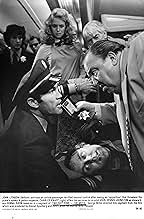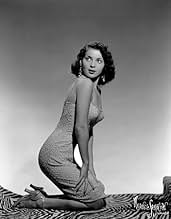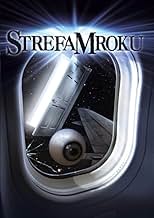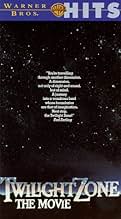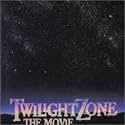Quattro storie di orrore e fantascienza, ognuna delle quali è una nuova versione di un classico.Quattro storie di orrore e fantascienza, ognuna delle quali è una nuova versione di un classico.Quattro storie di orrore e fantascienza, ognuna delle quali è una nuova versione di un classico.
- Premi
- 1 vittoria e 8 candidature totali
Rainer Peets
- German Officer (segment "Time Out")
- (as Remus Peets)
William S. Taylor
- G.I. (segment "Time Out")
- (as William B. Taylor)
Recensioni in evidenza
Five episodes realized as tribute to Rod Serling's Twilight zone, made by four known directors . It's is divided into 4 parts , three of them real remakes from classic television series, though starts in a prologue stars Albert Brooks and Dan Aykroyd . The best directed by John Landis is the first, where a bigot (played by Vic Morrow who died during filming by a helicopter crash accident) who becomes pursued of evil Nazis, Ku Klux Klan and American soldiers in Vietnam. The second segment directed by Steven Spielberg is a silly story about old people living in a retirement house who turn into little boys, thanks a strange visitor (Scatman Crothers). The third directed by Joe Dante concerns about a young woman (Kathleen Quinlan) encounters a kid with rare powers and some people (Kevin McCarthy, William Schallert,among them) closed at a strange house. And fourth episode titled 'Nightmare at 20.000 Feet' deals with a terrified passenger(John Lightow) who watch a creepy monster making rare issues on the wing of the plane.
The picture contains good special effects in traditional style without excessive computer generator as usual nowadays. The master Jerry Goldsmith composes a magic musical score particularly reflected on the second episode titled 'Kick the can' . Colorful and imaginative cinematography especially in the third segment titled 'It's a good life'. Rating : Acceptable and passable, the picture will appeal to fantastic genre buffs.
The classic long-running television series is formed by 156 episodes and its narrator , of course, Rod Serling. Later on, in 2002 are realized 44 new episodes with Forest Whitaker as host.
The picture contains good special effects in traditional style without excessive computer generator as usual nowadays. The master Jerry Goldsmith composes a magic musical score particularly reflected on the second episode titled 'Kick the can' . Colorful and imaginative cinematography especially in the third segment titled 'It's a good life'. Rating : Acceptable and passable, the picture will appeal to fantastic genre buffs.
The classic long-running television series is formed by 156 episodes and its narrator , of course, Rod Serling. Later on, in 2002 are realized 44 new episodes with Forest Whitaker as host.
It is very hard to think of another film anywhere that had such a great potential as TWILIGHT ZONE: THE MOVIE had, only to have a senseless and totally preventable tragedy--the deaths of actor Vic Morrow and two illegally hired Asian child actors--mar the impact. Aside from that, and some heavy-handed moralizing that even the original show's creator Rod Serling would have had problems with, this is a fairly good tribute to what was perhaps the best TV series in history.
The prologue (with Dan Aykroyd and Albert Brooks) and Segment 1 are both originals, written and directed by John Landis. The segment deals with a very embittered white man (Morrow) who, after being dealt the denial of a promotion at work in favor of a Jew, unleashes his bigotry at a bar. But when he steps outside, he soon gets a dose of his own bitter medicine: persecution by the Nazis in Vichy France circa 1943; stalked by the KKK in Alabama in 1956; attacked by US soldiers in Vietnam circa 1969. Landis' penchant for hamfisted dialogue and erratic direction dilute what could have been an effective piece; and the tragedy that occurred on his watch taints not only this segment but much of the rest of the movie.
Segment 2, a remake of the 1961 episode "Kick The Can", directed by Steven Spielberg, stars Scatman Crothers as an elderly magician who brings a sense of youth to the residents of a senior citizens home, though over the objections of a veritable old fuddy-duddy (Bill Quinn). Spielberg has often been attacked, mostly unnecessarily, for his tendency toward sloppy sentimentality, but here a lot of the attacks may be justified, despite the best of intentions. He is still my favorite director, but this is one of his weakest.
Segment 3 remakes "It's A Good Life." Under the inventive hands of director Joe Dante (THE HOWLING), this film stars Jeremy Licht as a boy with the power to enslave and terrorize his family when he comes to feel that they hate him. Kathleen Quinlan stars as the teacher who unintentionally gets caught up in the melee, only to wind up volunteering to teach Licht how to better use his powers before they become too big for him to control (a la CARRIE). Dante's use of inventive special effects (courtesy of Rob Bottin) and black comedy enliven this segment, despite some weird overacting from the rest of the segment's cast (including William Schallert and Kevin McCarthy).
Segment 4 is a reworking of the famous episode "Nightmare At 20,000 Feet." With George Miller (MAD MAX) at the director's helm, the segment stars John Lithgow as an incredibly anxious passenger with a morbid fear of flight who constantly sees a monstrous gremlin tearing apart at the wings of his plane during a severe storm. His anxiety explodes into terror and madness, and the other passengers think he is certifiable. But when the plane lands, and the damage is inspected...
The final score on this is that Landis and Spielberg, who also produced, come up with the weaker segments, and Dante and, especially, Miller come up with the best ones. Miller's segment is a truly kinetic piece of suspense and terror, though I did find the little girl (Christina Nigra) an extremely obnoxious and unnecessary presence. Lithgow, who takes over for William Shatner (who had the role in the TV episode), gives a bravura performance, arguably paving the way for his role in "2010" as an astronaut deftly afraid of heights.
Jerry Goldsmith's usual efficient score and some good special effects work help to make TWILIGHT ZONE: THE MOVIE not only an above-average tribute to a great TV show, but also a good anthology film that combines fantasy, suspense, and mystery. It is a shame that the film is tainted by a pointless tragedy. But if one can ignore that, there are rewards to be had by seeing this.
The prologue (with Dan Aykroyd and Albert Brooks) and Segment 1 are both originals, written and directed by John Landis. The segment deals with a very embittered white man (Morrow) who, after being dealt the denial of a promotion at work in favor of a Jew, unleashes his bigotry at a bar. But when he steps outside, he soon gets a dose of his own bitter medicine: persecution by the Nazis in Vichy France circa 1943; stalked by the KKK in Alabama in 1956; attacked by US soldiers in Vietnam circa 1969. Landis' penchant for hamfisted dialogue and erratic direction dilute what could have been an effective piece; and the tragedy that occurred on his watch taints not only this segment but much of the rest of the movie.
Segment 2, a remake of the 1961 episode "Kick The Can", directed by Steven Spielberg, stars Scatman Crothers as an elderly magician who brings a sense of youth to the residents of a senior citizens home, though over the objections of a veritable old fuddy-duddy (Bill Quinn). Spielberg has often been attacked, mostly unnecessarily, for his tendency toward sloppy sentimentality, but here a lot of the attacks may be justified, despite the best of intentions. He is still my favorite director, but this is one of his weakest.
Segment 3 remakes "It's A Good Life." Under the inventive hands of director Joe Dante (THE HOWLING), this film stars Jeremy Licht as a boy with the power to enslave and terrorize his family when he comes to feel that they hate him. Kathleen Quinlan stars as the teacher who unintentionally gets caught up in the melee, only to wind up volunteering to teach Licht how to better use his powers before they become too big for him to control (a la CARRIE). Dante's use of inventive special effects (courtesy of Rob Bottin) and black comedy enliven this segment, despite some weird overacting from the rest of the segment's cast (including William Schallert and Kevin McCarthy).
Segment 4 is a reworking of the famous episode "Nightmare At 20,000 Feet." With George Miller (MAD MAX) at the director's helm, the segment stars John Lithgow as an incredibly anxious passenger with a morbid fear of flight who constantly sees a monstrous gremlin tearing apart at the wings of his plane during a severe storm. His anxiety explodes into terror and madness, and the other passengers think he is certifiable. But when the plane lands, and the damage is inspected...
The final score on this is that Landis and Spielberg, who also produced, come up with the weaker segments, and Dante and, especially, Miller come up with the best ones. Miller's segment is a truly kinetic piece of suspense and terror, though I did find the little girl (Christina Nigra) an extremely obnoxious and unnecessary presence. Lithgow, who takes over for William Shatner (who had the role in the TV episode), gives a bravura performance, arguably paving the way for his role in "2010" as an astronaut deftly afraid of heights.
Jerry Goldsmith's usual efficient score and some good special effects work help to make TWILIGHT ZONE: THE MOVIE not only an above-average tribute to a great TV show, but also a good anthology film that combines fantasy, suspense, and mystery. It is a shame that the film is tainted by a pointless tragedy. But if one can ignore that, there are rewards to be had by seeing this.
"Twilight Zone: The Movie" is a mostly entertaining anthology film based on Rod Serling's classic TV series of the 1960s. Four bizarre tales are told through the minds of four different filmmakers: John Landis, Steven Spielberg, Joe Dante, and George Miller (Landis and Spielberg also produced). "Twilight Zone: The Movie" starts with a brief prologue starring Dan Aykroyd and Albert Brooks. Then comes segment #1, directed by Landis. This is the part of the movie that made headlines around the world when a freak accident killed actor Vic Morrow and two children while shooting a helicopter scene (which is not seen in the film). This story is about an angry man (played by Morrow) who is not happy with America because of all the different races that are living in the country. Then something strange happens. When the man steps outside of a bar, he finds himself on a street in Nazi Germany; a few minutes later he's confronted by the Klu Klux Klan; then he discovers he's in the middle of the Vietnam War; and so on. As for how this segment goes, it's only so-so. However segment #2, directed by Spielberg, is the weakest story of the bunch. Scatman Crothers stars as an elderly man who comes to live at a retirement home. After making friends with some of the elderly people living there, he talks them into playing a spirited game of kick the can. This is no ordinary game. Let's just say that its a game with a fountain of youth twist to it. I found this segment real boring. Up to this point, "Twilight Zone: The Movie" is disappointing. But then the film picks up with the strong last two segments. Segment #3, directed by Dante, stars Kathleen Quinlan as a woman who meets a little boy after accidentally knocking him off of his bike with her car. She decides to give the boy a ride home. But this is no ordinary home. It's a house where every TV set has a cartoon on, and the boy's family act like a bunch of crazy people (like their cartoons themselves). Quinlan begins to realize that this kid is not normal. This segment works because it's creepy (the look of the house on the inside is fascinating) and funny (every member of the kid's family is a complete nut). Ah, but the best segment comes last. Segment #4, directed by Miller, is a truly scary tale starring John Lithgow (from TV's "3rd Rock From the Sun") as a terrified passenger of an airplane flying through a severe thunderstorm. Things get worse when Lithgow see's something on the wing of the plane. What is it? A man? Or is it a monster? This segment literally had me on the edge of my seat. It's an excellent finale to "Twilight Zone: The Movie". So my advice is skip the first two segments, but watch the last two.
Here's my separate ratings for each segment (out of four stars):
Segment #1: **1/2; Segment #2: *1/2; Segment #3: ***1/2; Segment #4: ****
This adds up for an estimated combined rating of *** stars.
Here's my separate ratings for each segment (out of four stars):
Segment #1: **1/2; Segment #2: *1/2; Segment #3: ***1/2; Segment #4: ****
This adds up for an estimated combined rating of *** stars.
After the opening prologue with DAN AKYROYD and ALBERT BROOKS, as bored drivers on a lonely country highway who like to play pranks, TWILIGHT ZONE: THE MOVIE offers four stories, supposedly in the vein of stories that Rod Serling wrote for the famous TV series. Not until the final segment, NIGHTMARE AT 20,000 FEET does it offer the kind of fright stuff worthy of being in this anthology.
And it's a minor gem of its kind with JOHN LITHGOW giving an amazingly deft performance as a man totally afraid of flying who should have taken tranquilizers before he peered out the window. What he saw on the wing of the plane would have frightened anyone out of their wits--and, of course, no one believes him.
It's this final episode that makes the film itself worth watching. None of the other segments have enough punch to keep the viewer awake, let alone entertained. VIC MORROW's unfortunate accident came about during filming of a Vietnam sequence which does not appear in this version of the film--but he does give a convincing portrait of a bigot who gets his comeuppance. Very ironic.
Summing up: All of these stories were told with more style and suspense on the old TV shows. Strictly second-rate.
And it's a minor gem of its kind with JOHN LITHGOW giving an amazingly deft performance as a man totally afraid of flying who should have taken tranquilizers before he peered out the window. What he saw on the wing of the plane would have frightened anyone out of their wits--and, of course, no one believes him.
It's this final episode that makes the film itself worth watching. None of the other segments have enough punch to keep the viewer awake, let alone entertained. VIC MORROW's unfortunate accident came about during filming of a Vietnam sequence which does not appear in this version of the film--but he does give a convincing portrait of a bigot who gets his comeuppance. Very ironic.
Summing up: All of these stories were told with more style and suspense on the old TV shows. Strictly second-rate.
Prologue: a driver has a big surprise with his passenger (8)
Segment 1 ("Time Out"): a bigot man hates Jews, Black and Asian people. One day he will live in the World War II, hunted down by KKK and attacked in Vietnam War and feel the effects of his hatred. Good episode with a surprising conclusion (7).
Segment 2 ("Kick the Can"): In a nursing home, the elder inhabitants learn that their minds can keep them young. Reasonable episode only with a great homage to "The Twilight Zone" (Episode 3.21) "Kick the Can". (6).
Segment 3 ("It´s a Good Life"): a traveler hits a boy in a bicycle with her car and takes the boy home. Soon she learns that the powerful boy brought her home indeed. Good episode with a silly and disappointing conclusion (7).
Segment 4 ("Nightmare at 20,000 feet"): a writer is scary to fly and soon he sees a monstrous creature destroying the airplane engines during a stormy night. Certainly the best episode (8).
Divided in prologue and four segments, "Twilight Zone: The Movie" is a tragic and cult movie. Tragic since Vic Morrow, the unforgettable Sgt. Saunders of "Combat!" series, died in a weird accident when the helicopter crashed on him and two children while making a scene. Directed by four great directors - Joe Dante (segment "It's a Good Life"); John Landis (prologue/segment "Time Out"); George Miller (segment "Nightmare at 20,000 Feet"); and Steven Spielberg (segment "Kick the Can") - and with great names in the cast - Vic Morrow, Dan Aykroyd, Albert Brooks, Kathleen Quinlan, John Lithgow among many others, "Twilight Zone: The Movie" is highly recommended for fans of sci-fi and horror. My vote is seven.
Title (Brazil): "No Limite da Realidade" ("In the Limit of Reality")
Note: On 31 July 2023, I saw this film again.
Segment 2 ("Kick the Can"): In a nursing home, the elder inhabitants learn that their minds can keep them young. Reasonable episode only with a great homage to "The Twilight Zone" (Episode 3.21) "Kick the Can". (6).
Segment 3 ("It´s a Good Life"): a traveler hits a boy in a bicycle with her car and takes the boy home. Soon she learns that the powerful boy brought her home indeed. Good episode with a silly and disappointing conclusion (7).
Segment 4 ("Nightmare at 20,000 feet"): a writer is scary to fly and soon he sees a monstrous creature destroying the airplane engines during a stormy night. Certainly the best episode (8).
Divided in prologue and four segments, "Twilight Zone: The Movie" is a tragic and cult movie. Tragic since Vic Morrow, the unforgettable Sgt. Saunders of "Combat!" series, died in a weird accident when the helicopter crashed on him and two children while making a scene. Directed by four great directors - Joe Dante (segment "It's a Good Life"); John Landis (prologue/segment "Time Out"); George Miller (segment "Nightmare at 20,000 Feet"); and Steven Spielberg (segment "Kick the Can") - and with great names in the cast - Vic Morrow, Dan Aykroyd, Albert Brooks, Kathleen Quinlan, John Lithgow among many others, "Twilight Zone: The Movie" is highly recommended for fans of sci-fi and horror. My vote is seven.
Title (Brazil): "No Limite da Realidade" ("In the Limit of Reality")
Note: On 31 July 2023, I saw this film again.
Lo sapevi?
- QuizThe scene being shot at the time of Vic Morrow's fatal accident was added to the script late in the filming in an attempt to "soften" his bigoted character Bill Connor, and give him some redemption: while fleeing from an American helicopter attack on a deserted Vietnamese village, he sees two orphaned children. Bill decides to save them no matter what the cost, so he carries them under his arms and wades through the river to safety. He then finds himself back in Nazi-occupied France again, the two children having time-jumped with him. The two Nazi officers chasing Bill take the children away for execution, and take Bill to a train which ends the segment. Due to the helicopter accident that claimed the life of Morrow and child actors Renee Chen and My-ca Dinh Le, all scenes featuring the children were completely cut, and they do not appear in the film. Bill's original scripted ending was kept in, leaving Bill's character change largely unaddressed and his fate unknown.
- BlooperAn exterior shot of the airplane in Segment #4 shows the landing gear to be in the down position. The pilot later comments that the plane would be landing in twenty minutes, far too long for gear to be down prior to touchdown.
- Citazioni
Car Passenger: Hey... you wanna see something really scary?
- Versioni alternativeCBS edited 8 minutes from this film for its 1986 network television premiere.
- Colonne sonoreNights Are Forever
Performed by Jennifer Warnes
Music by Jerry Goldsmith
Lyrics by John Bettis
Produced by Bruce Botnick with James Newton Howard
[Segment #1: playing when William enters the bar]
I più visti
Accedi per valutare e creare un elenco di titoli salvati per ottenere consigli personalizzati
Dettagli
- Data di uscita
- Paese di origine
- Lingue
- Celebre anche come
- Al filo de la realidad
- Luoghi delle riprese
- 15238 Victory Boulevard, Van Nuys, Los Angeles, California, Stati Uniti(bar in segment #1; exterior & interior)
- Aziende produttrici
- Vedi altri crediti dell’azienda su IMDbPro
Botteghino
- Budget
- 10.000.000 USD (previsto)
- Lordo Stati Uniti e Canada
- 29.450.919 USD
- Fine settimana di apertura Stati Uniti e Canada
- 6.614.366 USD
- 26 giu 1983
- Lordo in tutto il mondo
- 29.450.919 USD
- Tempo di esecuzione1 ora 41 minuti
- Colore
- Mix di suoni
- Proporzioni
- 1.85 : 1
Contribuisci a questa pagina
Suggerisci una modifica o aggiungi i contenuti mancanti

Divario superiore
What is the Brazilian Portuguese language plot outline for Ai confini della realtà (1983)?
Rispondi


